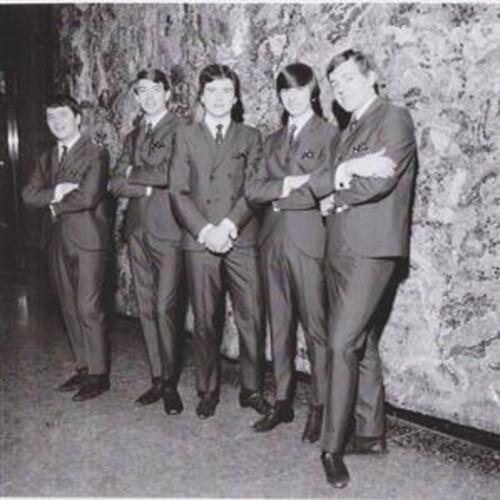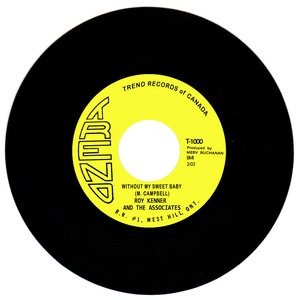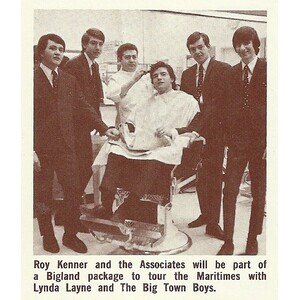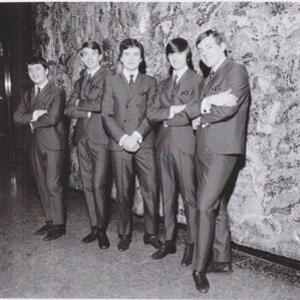Kenner, Roy and His Associates
Websites:
No
Origin:
Toronto, Ontario, 🇨🇦
Biography:
Roy Kenner & The Associates – Toronto’s Forgotten R&B Powerhouse
In the ferment of Toronto’s mid-1960s music scene, where Yorkville coffeehouses sat only a few blocks away from sweaty R&B dancehalls, one band managed to stand out for sheer firepower and charisma: Roy Kenner & The Associates. Though their time together was short and their recording legacy slim, they helped launch the careers of future Canadian rock stalwarts while capturing the raw energy of a city defining its own “Toronto Sound.”
Formation and Early Days
The Associates were assembled in 1964 by guitarist Tom Beavis, who was determined to build a sharp, club-ready R&B unit. He tapped bassist Greg Carducci (a schoolmate with no prior bass experience but plenty of determination) and went searching for the right voice to front the group. That voice turned out to be Roy Kenner, a fiery 16-year-old singer who had grown up in Toronto singing in church choirs and honing his chops at summer vocal programs in Port Hope.
Kenner’s rasp-tinged, gospel-inflected delivery was instantly magnetic. “We knew after one number that this was the guy,” one bandmate recalled. Soon the group solidified with drummer Ray Rychlewski and keyboardist Henry Babraj, who added Hammond organ textures to match the American soul records flooding north of the border.
Finding Their Sound
Unlike many local teen bands still dabbling in British Invasion pop, The Associates dug deep into American R&B and soul. Their setlists included Wilson Pickett, James Brown, and Ike & Tina Turner alongside blistering blues numbers. They rehearsed obsessively and invested in a proper Hammond B-3 organ—an expensive piece of gear that gave their sound a professional edge.
By mid-1965, they were union musicians playing Yorkville’s Purple Onion and east-end clubs like The Gogue Inn. Word spread quickly about their high-octane shows, thanks in part to Kenner’s showmanship: splits, mic-stand acrobatics, and James Brown-style screams that made teenage audiences swoon.
A Break with Trend Records
Toronto’s Modern Age Lounge—a club that became their de facto home base—the group befriended DJ and entrepreneur Merv Buchanan, who had just launched his TREND Records label. Sensing the potential of their live act, Buchanan set up a simple two-mic recording session after hours. The result was their lone single, “Without My Sweet Baby” b/w “Baby You’re What I Need” (1965).
Though crudely recorded, the A-side captured everything that made the Associates unique: a dark Hammond swirl, aching guitar lines, and Kenner’s voice tearing through the mix with desperate conviction. Pressed in a run of only 250 copies (with some single-sided promos circulated to DJs), the record has since become one of the rarest and most coveted artifacts of the Toronto R&B scene.
On Stage with the Greats
What The Associates lacked in radio play, they made up for on stage. With bookings handled by Ron Scribner’s Bigland Agency, they soon found themselves opening for James Brown, Wilson Pickett, and Ike & Tina Turner on their Toronto stops. Local bands like The Rogues (later Mandala) took notice of Kenner in particular, recognizing his potential to hold a crowd alongside the international stars.
They also played at the legendary Toronto Sound Showcase at Maple Leaf Gardens in September 1966—a fourteen-hour marathon featuring the city’s top bands. Sharing the bill with The Paupers, Ugly Ducklings, and Luke & The Apostles, the Associates stood shoulder to shoulder with the era’s best.
The Maritime Tour
In 1966, Bigland paired The Associates with pop star Lynda Layne and hitmakers The Big Town Boys for a multi-city tour of the Maritimes. It was their first taste of one-night-stands and arena stages, and while audiences responded enthusiastically, the trip turned rough. Equipment was stolen, money went missing, and the band literally had to hitchhike back to Toronto after the cash ran out.
Though disillusioning, the experience showed their resilience. Keyboardist Henry Babraj even filled in for The Big Town Boys on short notice when tragedy struck their lineup, learning an entire set overnight and performing flawlessly.
Dissolution and Aftermath
By 1967, mismanagement and morale issues caught up with the band. A poorly conceived stint playing at a Sudbury carnival (where fans could hear the band from outside the tent and refused to pay admission) proved the breaking point. Hungry, broke, and directionless, The Associates called it quits.
Their breakup coincided with a wave of change across Toronto’s R&B scene: Jon-Lee & The Checkmates dissolved, Mandala retooled, and clubs shifted to harder-edged rock. But from these endings came new beginnings. Guitarist Domenic Troiano, looking to rebuild Mandala after George Olliver’s exit, invited Kenner and Babraj to join. This move set Kenner on a path that would soon see him fronting Bush, touring with the James Gang, and later co-founding Law in the 1970s.
Other members found different paths: Carducci, Rychlewski, and Chirowski (ex-Checkmates) regrouped in projects like Freedom Fair, while Tom Beavis and others drifted away from music altogether.
Legacy
Roy Kenner & The Associates never scored a chart hit, yet their importance lies elsewhere. They were among the first Toronto bands to bring uncompromising R&B to teen audiences, to record for an independent local label, and to serve as a proving ground for musicians who would go on to major careers. Their sole TREND 45 remains a prized collector’s item and a snapshot of a scene that helped define Canadian soul and rock.
Kenner’s later success ensured his name endured, but the Associates deserve equal recognition as one of the hardest-working and most electrifying groups of the Toronto Sound era—remembered by those who saw them as a band that truly “lived their music.”
-Robert Williston



